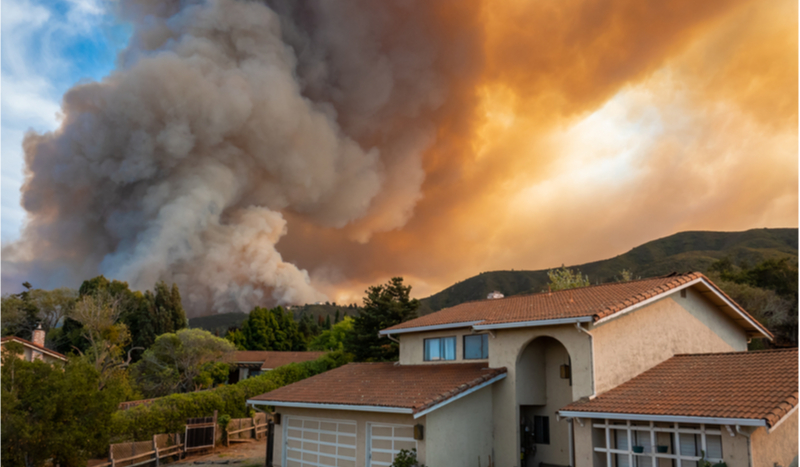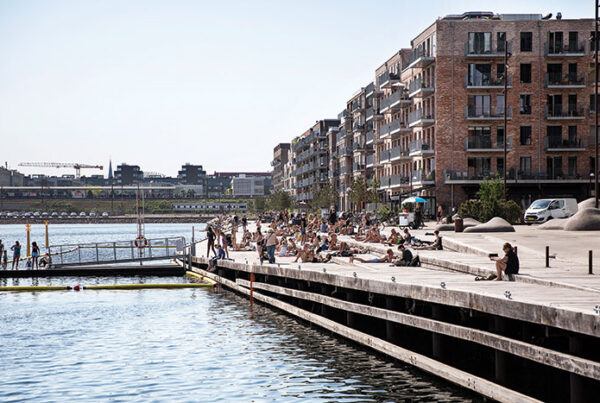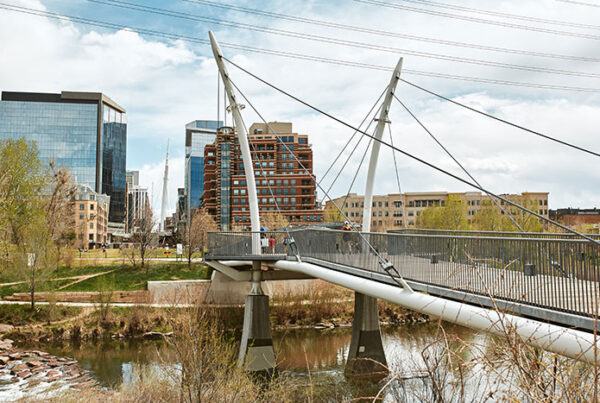
(Shutterstock)
There is a 90 percent chance that a home will be destroyed if an ember ignites on the building during a wildfire, according to post-fire investigations conducted by the Insurance Institute for Business and Home Safety (IBHS). IBHS leaders demonstrated how resilient building materials and landscape methods can avert damage, during a live fire demonstration during a ULI webinar hosted for 10 district councils in June.
As climate change worsens and the frequency of wildfires increases, Western U.S. states have become all too familiar with the devastating effects. For example, California experienced six of its largest-ever fires in 2020, and other western states are preparing for a potentially difficult season given the current drought conditions. Firebreak, a ULI Urban Resilience report, noted trends among leaders in the industry and membership, which are increasingly preparing for longer and more dangerous fire seasons, as are local governments such as Sonoma County, California, which recently hosted a ULI Advisory Services panel.
What can be done to better prepare buildings and development from these significant risks? Roy Wright, president and CEO of IBHS, along with Daniel Gorham, research engineer for the Wildfire Program at IBHS, addressed this question and others through a live wildfire demonstration hosted exclusively for ULI. The full-length presentation, which was jointly hosted by ULI Arizona, ULI Austin, ULI Colorado, ULI Houston, ULI Idaho, ULI Orange County/Inland Empire, ULI Sacramento, ULI San Diego-Tijuana, ULI San Francisco, and ULI Utah, is accessible on Knowledge Finder.
After the demonstration, a response panel including Lisa Micheli, president and CEO of Pepperwood Preserve in California, and Dan Richter, managing partner for Avimor Development in Idaho, explored how real estate developers and institutions can use wildfire-resilient design methods and how these best practices align with strategies underway at their projects.
“We’re in a season right now with drought and heat continuing to make headlines,” said Wright. “Which means western communities are left grappling with the risk of wildfire.”
The key to understanding successful wildfire preparedness, Gorham explained through the demonstration, is to understand that embers are at the core of built environment ignition. Embers are the small pieces of burning coal that can travel up to a full mile (1.6 km) and float into a home through an open window or an HVAC unit, ultimately igniting and quickly spreading from the outside of the house, up the eaves, and into the attic. Even indirect ember ignition from catching on a plastic fire hose reel or doormat, the mulch, or vegetation outside a home can lead to disastrous effects.
“It’s like a freight train once it starts,” Gorham said, referencing the cascading effects of fuel availability, ember spread, and wind dynamics. The demonstration contained 12-mile-per-hour (19 km per hour) winds, which he noted would be modest in a real wildfire scenario. In the excerpted clip from the demonstration, Gorham walks viewers through the difference between fires and other climate hazards given their binary nature—if an ember ignites, the effects will be far reaching.
This is why the first five feet (1.5 m) surrounding the perimeter of a property, or what is known as “the Immediate Zone” by the National Fire Protection Association, is considered the most important defensible space around a structure. The IBHS team proved this point through its demonstration, which reinforced the importance of fire-resistant materials and defensible space. Gorham walked viewers through the potentially catastrophic effects of flammable mulch and non-native shrubbery as the test house was engulfed in flames, showcasing the result of ember transmission. Minimizing risks or potential hazards in the five-foot (1.5 m) perimeter of a home helps with this effort. Tactics such as using decorative rocks in place of mulch, keeping vegetation hydrated, and removing plastic materials from the first five feet are simple steps toward preventing ember ignition.
Looking toward new development, Gorham recommends that building codes, standards, and requirements be updated to require resilient building materials in new construction. For the large existing inventory of buildings that have not been consciously designed with an eye toward fire protection, IBHS has designed Suburban Wildfire Adaptation Roadmaps that offer guidance toward retrofitting existing suburban housing stock to guard against ember spread.
Pioneering developments such as Avimor, a 23,000-acre (9,311 ha) master-planned community located in the Boise, Idaho, foothills, are paving the way toward proactive wildfire resilience. At its completion, Avimor will consist of 12,000 homes and 900,000 square feet (83,600 sq m) of commercial property. The community has been intentionally designed so that 16,000 acres (6,500 ha) will be left as their native grasslands and open space. Avimor is one of the first communities in the nation to earn the Firewise USA certification as a new large development—a title that Richter takes very seriously.
“It’s important at Avimor that we understand it’s not if we have fires on our range land, but when,” Richter said, explaining the thinking behind the Firewise community designation.
The green space at Avimor serves both as a natural firebreak, or barrier, and an important amenity for the development. The development team’s strategies for preserving the space include using cattle to consume grass and potential fuel for fires. In addition, the HOA art of living director ensures that education on fires is baked into every new resident’s move-in materials. Since many of Avimor’s current residents have relocated from California, most understand the sensitivity of the issue and thus the market signals that this tenant/owner education is well received. ULI’s Urban Resilience program dug further into Avimor Development’s wildfire resilience strategies in a case study on Developing Urban Resilience.
Similarly, the Pepperwood Preserve, a 3,200-acre (1,300 ha) research preserve in Northern California, focuses on bringing science to wildfire resilience. The preserve experienced substantial destruction from the Tubbs Fire in 2017, but a lesson was learned as one of their research buildings made of glass, concrete, and steel was completely intact. During the rebuild, the team opted for ignition-resilient design of what were previously wood buildings: inside is wood frame, but the outside is made more resiliently with Hardie board and stucco.
“We are very adherent to defensible space,” Micheli said, in reference to the Pepperwood rebuild process following the fire. “There’s rock mulch all around these buildings for the entire five-foot perimeter.”
Micheli went on to explain the difficult process behind insuring their newly rebuilt spaces. The team at Pepperwood went above and beyond building requirements, which led to insurance difficulties. “Our primary insurer would not insure the buildings,” she explained. “We went to 30 providers and found one policy that was prohibitively expensive.” In the end, only 60 percent of Pepperwood’s construction costs were covered by insurance.
Although there is no one simple solution to wildfire resilience, Gorham remains hopeful that education will pave the way for resilient adaptation. “Being educated, understanding embers, understanding community and building features, these are so important to understanding these fires,” he said.




